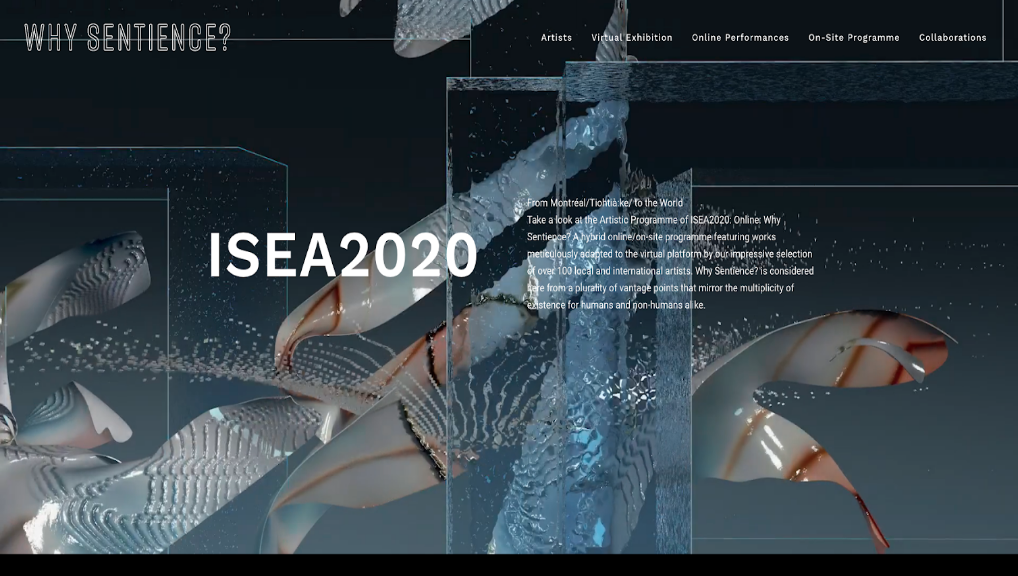ISEA2020 Online and Onsite Programme
October 13 – 18 2020
URL: art2020.isea-international.org
Curatorial Statement
ISEA’s 2020 artistic program explores the infinitely large and the infinitely small worlds of Sentience — feeling-sensing-making sense.
There were to be seven exhibitions across various venues for the ISEA2020 artistic program, until the city’s shutdown in March 2020, here as elsewhere, of all non-essential businesses to prevent the spread of COVID-19. Nevertheless, two core themes had already been identified running through the exhibitions.
The first was a careful attention to scale and scalar complexity in the age of the Anthropocene. The selected works not only share a collective sense of urgency to rethink relationships between sentient beings — human, non-human, more-than-human — in different times and spaces, but also engage in vastly disparate scales ranging from the extraterrestrial and planetary to the bodily and microscopic. Among the calamities scientifically linked to human activities, climate change most vociferously connects socio-economic tipping points to changes in the planet’s geological scales as well as microbial worlds.
The second theme explored the human sensorium — touch, taste, smell, as well as sight and hearing. Sue Huang’s multimedia installation In the Time of Clouds (2019) explores sensorial relationships to clouds and on our collective imagination on their shapes and taste. Custom-made ice cream—a tangible product of this collected data—can be sampled by spectators, the cool dessert acting as a sweet unifier of our perceptions of clouds. Stephanie Rothenberg’s Aquadisia (2020) is an immersive installation that invites viewers to recline in comfortable chairs, take in three looped videos, and interact with a soft robotic sculpture of a cyborg oyster, with the option of tasting the amino acid liquid produced by the oyster via a series of tubes. Guillaume Cousin’s Le silence des Particules (2018), a large-scale installation using a machine-cannon that cyclically projects ephemeral large circles of smoke moving slowly in the glow of warm light, and leaving a slight trail as they pass and slowly disappear. In a room with extremely controlled light, Le silence des Particules renders visible, almost tangible, the billion particles that form each gram of matter.
With ISEA2020’s transition to an online format, the challenge was to present a series of virtual exhibitions that would bring these different scales and senses together in a meaningful way while at the same time respecting the nuances of each work. Fathoming online versions of work intended for physical spaces was simply not possible; a poor and disappointing imitation of the “real” project would almost certainly be the result. As much as we are plugged in and connected through the Internet, most of us need and miss embodied experiences of the world. Among the simpler things in life yearned is walking excitedly into a gallery free of safety measures concerning every breath taken.
By June, the global pandemics of COVID-19 and systemic racism that amplified the health precarity disproportionately impacting Indigenous and other racialized communities and the urgency of the Black Lives Matter movement against policing, pressed gravely upon us even more than before about why sentience matters today. The capacity to feel, the ability to care, to sense and make sense of what it is to be a subject of experience – to be conscious. Of the unconscionable.
The intersections of artistic, scientific, and media narratives play a pivotal role in feeling, coping with and making sense of not only this moment but also of all our relations. Climate futures, biodiversity, multi-species survival, and thrivance, also depend on it. We can no longer deny the place of human beings in this world is simply as another vulnerable species; we are no more immune from ourselves than from other forms – sentient or not, and neither are we separate.
Presented on both the ISEA2020 Online platform and on a separate dedicated website, ISEA2020’s artistic program embodies this urgency to decenter inherited anthropocentric, or human-centred views, so that we can not only see but feel and sense ways to deepen relationships with other systems and forms of being. Touch and be touched; then act.
Erandy Vergara Vargas and Alice Ming Wai Jim
ARTISTS: ISEA2020 featured more than one hundred international and Canadian artists, including: Klaus Spiess & Lucie Streckera [DE], Stephanie Rothenberg [US], Afroditi Psara [GR/US]] and Audrey Briot [FR], Marco Barotti [IT/DE], Elizabeth Demaray [US], Sölen Kiratli [TR/US] and Akshay Cadambi [IN/US], Louise Mackenzie [UK], Allison Moore [CA], Lisa Moren and Tsvetan Bachvaroff [US], Scott Benesiinaabandan [CA], Malizin Cortes and Ivan Abreu [MX], Alice Jarry [CA], Sophia Brueckner [US], David Garneau [CA], Suzanne Kite [US] and Rea Noir [AU], Quentin VerCetty [CA], Ian Clothier [NZ], Teresa Connors [CA], Matthew Mosher [US], Pavitra Wickramasinghe [LK/CA], Mo H Zareei [IR/NZ].
